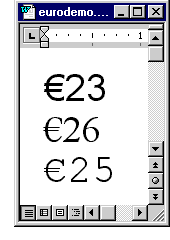Note
Access to this page requires authorization. You can try signing in or changing directories.
Access to this page requires authorization. You can try changing directories.
The euro is the name given to the single currency of the European Union. The euro was introduced as a currency on 1 January 1999 and was soon in common use.
Some thirty draft designs for a euro currency symbol were drawn up internally by the European Commission. Of these, members of the general public assessed ten, narrowing the shortlist to two designs. The final design was chosen by Jacques Santer, president of the European Commission, and Yves-Thibault de Silguy, the European commissioner in charge of the euro.

The euro currency symbol has been encoded in Unicode as U+20AC.
While the European Commission created a design specification for the euro currency symbol, Microsoft and other vendors have chosen to make glyphs for the symbol to be font and style specific—so the design of the symbol takes on the characteristics of the font in which it resides.
Traditionally numerals and currency symbols are the same width for any given font. This helps values line up properly in tabular applications like spreadsheets. So, for instance, to make the euro symbol the correct width for the Arial and Times New Roman fonts, the design had to be condensed compared to the European Commission design specification.
This same design principle is recommended for currency symbols in general: official design specifications may be required in some contexts, but in most fonts glyphs for currency symbols should be adapted to be appropriate for the given font.